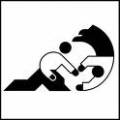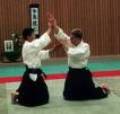
 |
 |
 |
 |
Aikido Technique Reviews
Aikido Technique
The dynamics of Aikido's techniques
Due to the dynamic nature of Aikido, most experts say that there are no definite " styles " or " techniques " in practicing the martial art. After the development of aikido by Morihei Ueshiba, called " O Sensei, " many students were inspired to train under his tutelage.
After their training, the Great Teacher encouraged his students to put up their own dojos so they engagement spread the tenets of his martial art. Aside from encouraging them to set up dojos and income the knowledge he taught, he also inspired them to prosper their own styles and interpretations as lengthy as these techniques adhere to the basic principle of aikido, " not fighting force with force. "
The aikido founder reiterates this principle over and over again because the techniques of aikido, when applied without care, can damage or kill instead of fun or immobilizing the antagonist.
With the emergence of various dojos all over the world, more and more techniques were born. Despite the differences in techniques in various dojos, there is a set of the common techniques in which almost all dojos use. Each of this technique is carefully taught to the student so he or she can discover its strengths and weaknesses.
Although most people say that there should buy for no superior or inferior technique, only the student or the individual practicing it can truly tell which technique works well for him or her. Here is a list of the most routine aikido techniques practiced by almost all aikido practitioners in dojos today:
1. " Ikkyo ". Also known as the " first technique, " ikkyo refers to the control exercised using only one hand on the elbow and the other one on near the wrist that leverages " uke " to the ground. This technique uses a grip that can apply pressure into the ulnar nerve on the medial side of the person's arm.
2. " Nikyo ". This is referred to as the " second method. " Nikyo involves the use of an adductive wristlock that loops the arm while applying painful nerve pressure.
3. " Sankyo ". This is also called the " third technique. " Sankyo is confessed as a " pronating " technique that directs upward - spiraling pressure throughout the person's arm, thrust, and shoulder.
4. " Yonkyo ". Is also confessed as the " fourth technique. " Just like iikkyo, yonko is also a shoulder control but with requires the usage of both hands in gripping the forearm. The practitioner's knuckles—usually from the palm side—are applied to the opponent's radial nerve against the forearm bone.
5. " Gokyo ". This refers to a variant of ikkyo where the hand that grips the wrist is inverted. Also known as the " fifth technique, " gokyo is common in tanto and peculiar weapon proceeds - aways.
6. " Shihonage ". Here, the practitioner's hand is folded back past the shoulder and locks the shoulder joint. This aikido technique is also called the " four - direction throw. "
7. " Kotegaeshi ". This is popularly called the " wrist return. " This aikido technique is a characterized by a supinating wristlock - throw, which stretches the person's extensor digitorum.
8. " Kokyunage ". In English, this is translated to " verve throw. " This term is coined for various types of flowing " timing throws " in duration of any aikido session.
9. " Iriminage ". For aikido practitioners, this is recognized as the " entering - body throw " or throws where " nage " moves through the space occupied by " uke. " This is considered as a classic form that resembles the " clothesline " technique.
10. " Tenchinage ". A. k. a. the " heaven - and - earth throw. " This manner involves the " uke " grabbing both wrists of the " nage. " Moving chivalrous, the nage sweeps one furtherance disconsolate ( " earth " ) and the other high ( " heaven " ), so he or she can unbalance the uke.
Share This With Your Friends |
More Aikido Technique Articles
... not since common in feudal Japan, where aikido originated. Here are some forms of strikes that are often used. facade - thrust Although the aikido name, Ganmen - tsuki, can be absolutely complicated, it is basically a punch directed to the face. Front - face Called Shomenuchi in aikido language, it is ...
... and karate are acceptable. Judo jackets are thicker and are built for durability since in judo the jacket receives considerable stress from the techniques identical seizing and throwing. For aikidokas, judo jackets might be advisable since some Aikido techniques also involve some keikogi grabbing which ...
... into throws, locks, and several restraining techniques. Since aikido uses very few punches and kicks, the size, weight, age, and physical strength of the participants or the opponents unparalleled partake only a small role. What's important is the skilled Aikido practitioner is skilled enough to redirect ...
... from neighboring gym auditorium or from the enthusiastic convocation inside the dojo. After filming, they upload these files into the Internet so others can see it. Although these are just short clips, there is a possibility that you pick up aikido techniques that you can practice. Unlike in full - length ...

|
| Copyright © 2006-2012 Internet Marketing Tools, All Rights Reserved |